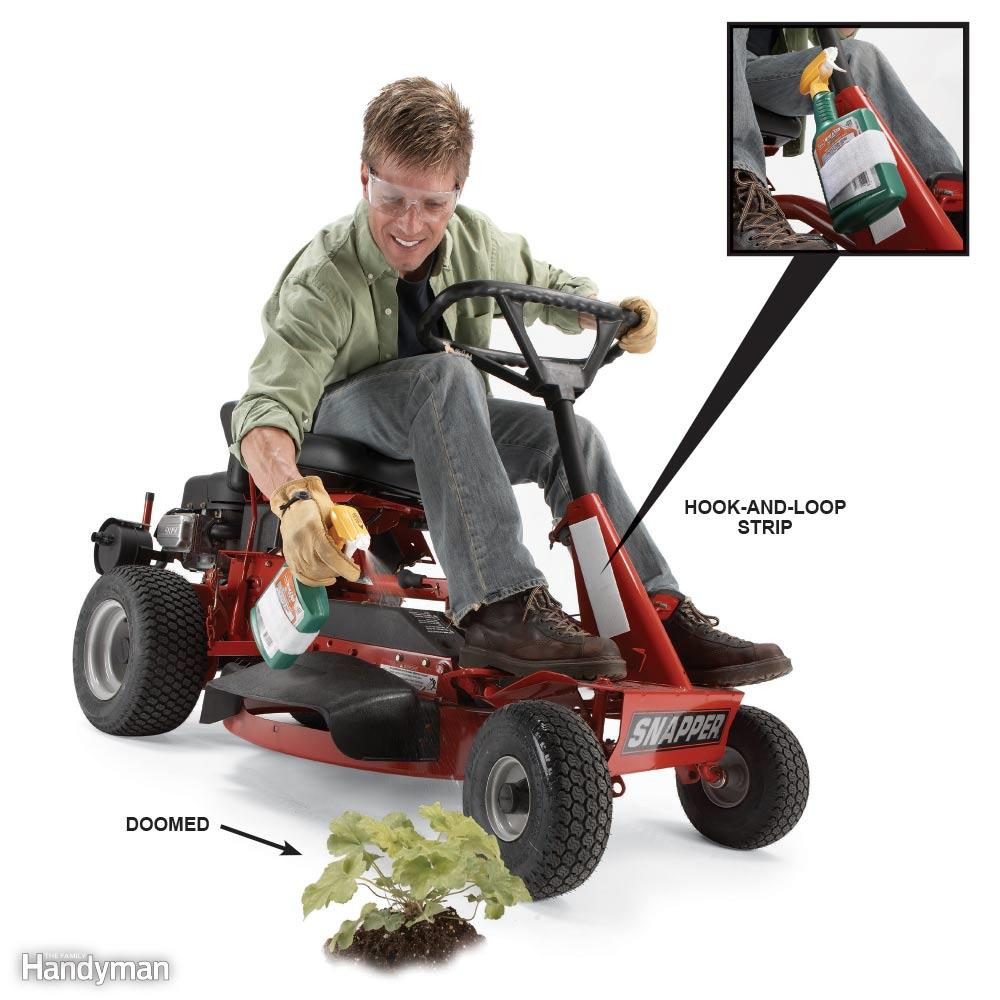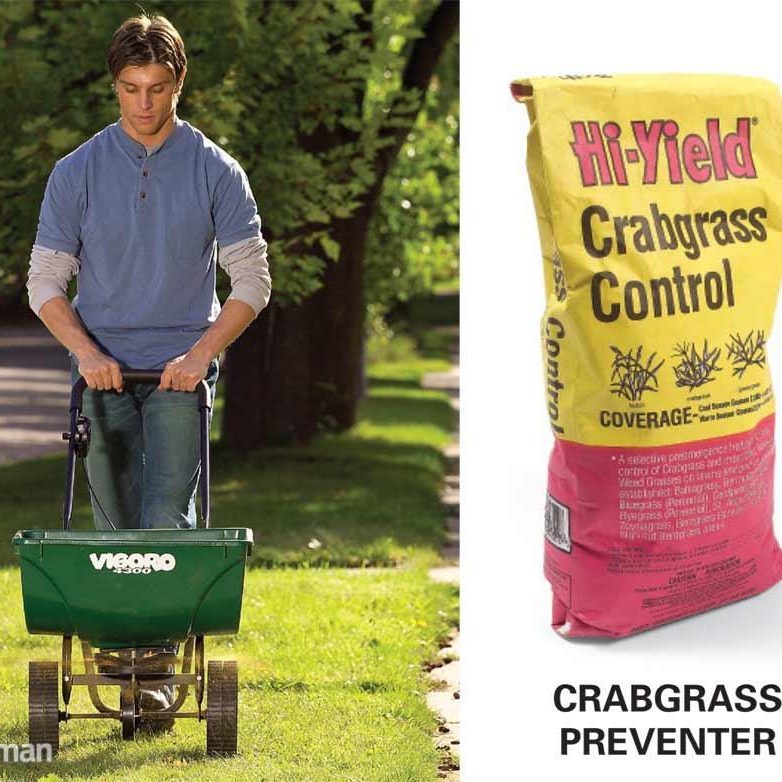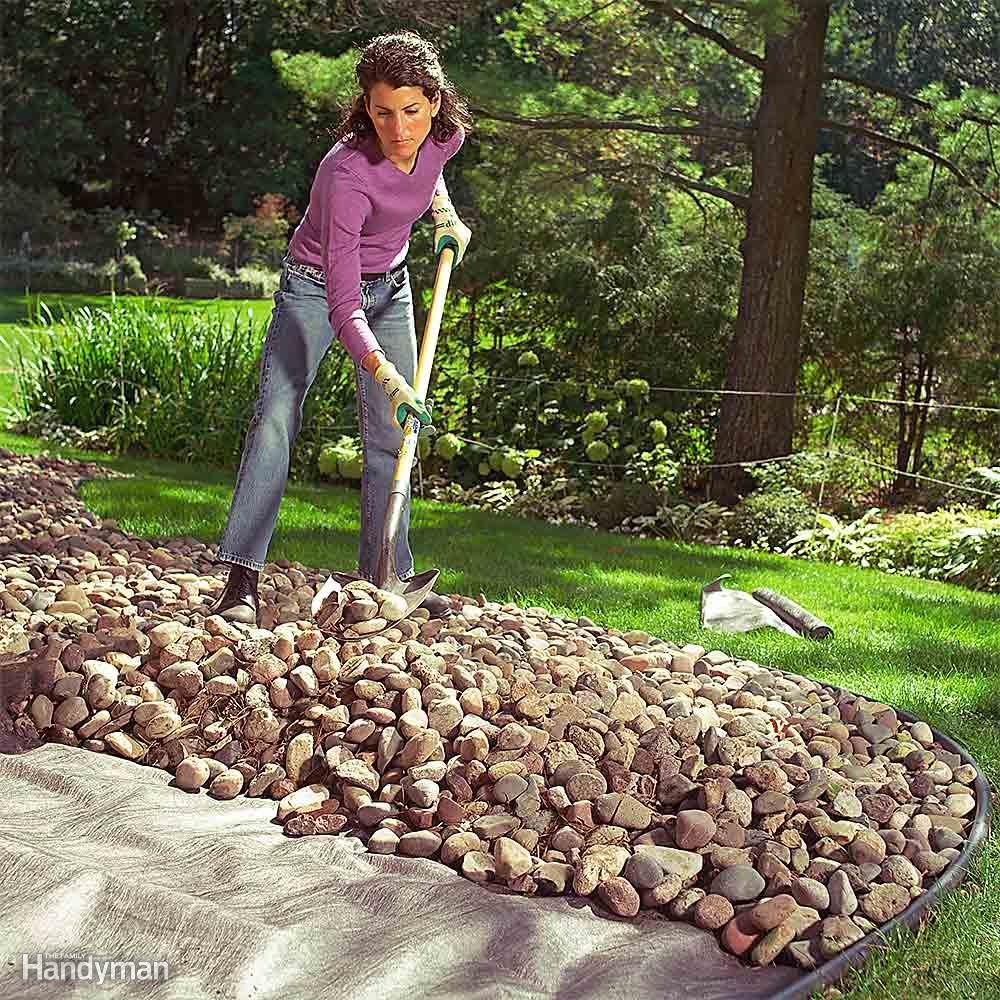Use these tips to banish weeds from your yard once and for all.
Tips for a Weed Free Yard

Drive-By Weeding

How Thick Should I Apply Organic Mulch?
A layer of mulch 3 to 4 in. deep will keep most weed seeds in the soil from sprouting and increase moisture retention. However, more isn't always better. Limit the depth to 5 to 6 in., especially around shallow-rooted plants. And pull back mulch from the base of plants so it doesn't cause rot.
If you want to use organic mulch on slopes, apply a shredded type about 6 in. deep. It'll mat together and stay in place better than a thinner layer.
Note: Cocoa bean mulch is popular in some areas because of its deep brown color and chocolate odor. But it's a bit tricky to use effectively. Apply it no more than 1 in. thick, because thicker layers tend to retain too much water and become moldy. You may also have to replenish it more often because it blows away easily when dry. Also be aware that dogs can get sick if they eat or chew on this mulch.

Should I Use Landscape Fabric Under Mulch?
Use fabric only under stones and gravel. It'll keep the rocks from sinking into the soil and make removal much easier if you want to change it later. The fabric will also slow down weeds that have rooted in the soil. Choose a fabric that allows water and air to pass through. Avoid using impermeable plastic, especially if you have trees, shrubs or other plants nearby.
Unfortunately, landscape fabric also makes weeding extremely difficult; you can't get a shovel down through the rock and fabric. And it's tough to pull weeds that root into the fabric.
Don't use fabric under organic mulches. It's better to let them decompose and mix into the soil.

Apply a Preemergent Herbicide

Set Your Blade at the Right Height to Control Weeds
Cutting grass too short weakens it. Longer grass grows stronger and thicker and crowds out weeds. Weed seeds can't germinate easily since they don't get much light. Established weeds have a tougher time competing with the surrounding turf.
Each type of grass has an ideal mowing height to maintain its health and thickness. It's about 2-1/2 in. for most cold-climate species. Cut most warm-climate grasses a bit shorter: 1-1/2 to 2 in. If you're not sure of your grass type, take a sample to a local nursery. Or type 'identify grass' into an online search engine for help. Although most lawns contain a mix of grass types, they should have similar ideal cutting heights.

Weedy Tip
When you sow seeds, it can be hard to tell little weeds from the young sprouts. Cut cardboard tubes from toilet paper into one-third sections to encircle the seed and keep you from plucking out your young plants.

Which Organic Mulch Lasts the Longest?
In general, pick a type with larger chunks, because it'll decompose more slowly. And choose bark-type mulches (such as pine bark nuggets) before shredded wood types (such as cedar, cypress and hardwood). Keep in mind that mulch reduces maintenance but doesn't eliminate it. Organic mulches have to be replenished periodically, usually every two to three years.

Will Mulch Stop Weeds?
Mulch won't stop weeds completely. Applied deep enough, it will prevent many weed seeds already in the soil from germinating and growing. But it won't stop weeds that have already rooted. Tough weeds like dandelions will push right through if you don't dig them out first. And more weed seeds will blow in and take root in the mulch (in both organic and stone). All mulch-covered gardens require maintenance, though less than if you don't use mulch.

Healthy Grass Is the Best Weed Preventer

Plant Hardy Ground Covers in Shady Areas
Grass is a sun-loving plant. It typically needs six to eight hours of sunlight daily for good health. While several shade-tolerant species may do OK under trees and in other sheltered spots, it's more likely that you'll end up with weeds, scraggly grass and bare ground. It's much better to plant a shade garden or a shade-tolerant ground cover that in a few years will blanket the area like a green carpet. And you won't have to mow. A local nursery expert will advise you on which plants and ground covers do best in your region.

Kill Broadleaf Weeds: Early Season
A broadleaf weed is any undesirable lawn plant that isn't a grass. Dandelions, plantain, ground ivy (creeping charlie) and ragweed are a few of the most common broadleaf weeds. Before broadleaf weeds start growing in the spring, apply a product called Hi-Yield Turf & Ornamental Weed & Grass Stopper Containing Dimension, which is a preemergent herbicide. It kills weeds before they sprout from seed and even kills some weeds that have just started to grow. Park your broadcast spreader over a tarp or on the driveway (grains may leak out, and a heavy dose of herbicide on the yard can kill even healthy grass). Fill the spreader and distribute the herbicide evenly over your lawn between your first and third mowings in the spring. The company says a single application will last a full 120-day season. It's available at lawn and garden centers (call first to make sure). A 35-lb. bag treats up to 15,000 sq. ft.

Kill Broadleaf Weeds: Late Season
If a few broadleaf weeds pop up in the yard (you can always count on a few dandelions), spot-kill them with a post-emergence herbicide such as Ortho's Weed-B-Gon MAX (a 32-oz. bottle of concentrate covers 16,000 sq. ft.). Look on the label for “broadleaf killer” then check to see which weeds it targets. Some broadleaf herbicides also kill crabgrass. There's no need to treat the entire lawn, just the weedy areas. Don't let them spread and create a bigger problem. Premixed herbicides are OK if you have a small lawn and only a few weeds. Otherwise, buy concentrates to mix yourself—they're a better value. Wait until the temperature is between 60 and 85 degrees F. Mix the herbicide with water (follow the directions) and pour it into a small pump sprayer. Keep the nozzle 6 to 12 in. from the weed and spray until the leaves are slightly wet.

Kill Annual Grassy Weeds: Early Season
Annual grassy weeds sprout from seed each year. The weed dies in the fall, leaving behind seeds that germinate the following spring. Crabgrass is the most notorious grassy weed, but there are others, like yellow foxtail and nutgrass. Use a preemergent herbicide to kill annual grassy weed seeds in the spring before they germinate. Crabgrass preventer is the most common, but you might as well apply an herbicide containing Dimension in the spring because it also kills broadleaf weed seeds. Crabgrass often thrives along sidewalks and driveways because the ground is warmer there, so be sure to apply herbicide in those areas.

Kill Annual Grassy Weeds: Late Season
The best way to handle a few scattered annual grassy weeds is to spot-kill them with a postemergence herbicide that's formulated for grassy weeds, such as Ortho's Grass-B-Gon. Look for Grass Weed Killer or Crabgrass Killer on the label (Crabgrass Killer kills other grassy weeds too). Mix the concentrated herbicide with water (per manufacturer's directions), then pour the mixture into a handheld sprayer. Spray the individual patches of weeds. To ensure that there's plenty of plant material to absorb the weed killer, don't mow the weeds just before applying the herbicide or for three days after. Always read the herbicide's label before applying to make sure it will kill the targeted weeds and not harm your lawn.

Kill Perennial Grassy Weeds: Too Late
Once there are too many weeds to spot-treat by hand, it's time for draconian measures. Kill everything and start over. Spray a nonselective herbicide on the weedy area and wait two weeks. If they're not dead, spray them again. Once the weeds are dead, mow them as short as possible. After spraying the herbicide, wait 14 days to plant new grass so the herbicide won't kill it.

Identify Weeds Before Planning the Attack

Treat Weed Patches With a Small Tank Sprayer
Patches or clumps of weeds are best treated with a standard 1- or 2-gallon tank sprayer. After spraying, triple-rinse the tank with water. With each rinse, pump up some pressure and flush out the wand, too.

Use a Dial Sprayer When Weeds Are Out of Control
If your whole lawn is filled with weeds, a dial sprayer attached to your garden hose is the answer. It's fast and efficient. It's just a matter of adding concentrated broadleaf killer to the pot, and setting the dial at the top to the mixture called for on the herbicide container—for example, 2-1/2 tablespoons per gallon of water. Then hook up the garden hose and apply an even treatment to the weedy areas. Clear the yard of toys, furniture and anything else that can get contaminated by overspray. And be sure to protect your flowers and bushes with plastic sheeting or cardboard. Remember that broadleaf killers will kill or harm anything with leaves—including your flower bed.

Kill Perennial Grassy Weeds One By One
Quack grass is the widest spread example of a perennial grass that comes back year after year just like your lawn. It spreads through seeds and extensive underground root systems and is unaffected by broadleaf killers. Pulling grassy weeds only gets some of the roots, and the remaining ones will quickly sprout new plants. The best way to kill these weeds while protecting surrounding plants is by wiping the grass blades with a nonselective herbicide like Super Kills-All or Roundup. Wear a cheap cloth glove over a plastic or rubber chemically resistant (they're labeled as such) glove to protect your skin. Dip your gloved hand into the herbicide and then simply grab the blades near the base and pull the herbicide over the grass blades. Don't worry about coating every single blade. The chemical will absorb into the plant, make its way down to the roots and kill the entire plant. Most will die in a few days, but survivors may need more treatments.

Don't Fight Weeds Where Grass Won't Grow

What's the Best Weed Barrier?
You have two good choices for the best weed barrier—organic mulch or high-quality landscape fabric. (Don't use black plastic. It doesn't allow rain to reach plant roots, and it traps water vapor, which facilitates the growth of mold and mildew.) An organic mulch such as shredded bark, in a layer several inches deep, will help control weeds. It will also decompose over time, which will add organic matter to the soil and make your tree happier. However, you'll have to add more organic mulch every couple of years. Landscape fabric, when protected from sunlight, decomposes more slowly than organic mulch and doesn't need to be replaced as often. However, the type of landscape fabric makes a difference. Hold the fabric up to the light and make sure the pores in the fabric are small enough to prevent weeds from growing through the barrier. Also, a good-quality landscape fabric is one you can't tear or stretch easily. It should feel stiff, not flimsy and limp.

Use Landscape Fabric Staples to Anchor the Seams
The seams in landscape fabric in planting beds often open between sections. To solve the problem, use landscape fabric staples. You'll find them right next to the fabric in stores. Make sure the edges of the fabric overlap by at least 3 in. And don't skimp on the staples; place them about 16 in. apart. Also use staples to anchor landscape fabric around the perimeter. In hard soil, start the staples by hand and then push them in with your foot.

















